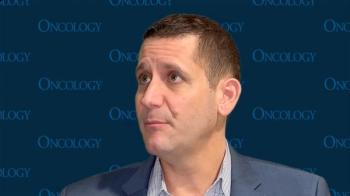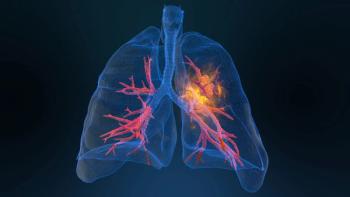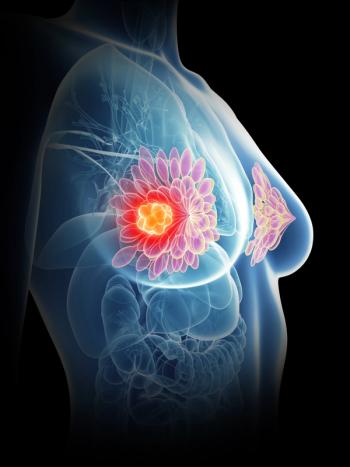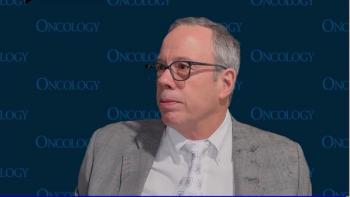
Lasofoxifene Plus Abemaciclib Induces Response in Previously Treated ER+/HER2–/ESR1+ Metastatic Breast Cancer
Patients with acquired ESR1 mutations after disease progression and post-treatment for locally advanced or metastatic estrogen receptor–positive, HER2-negative breast cancer may benefit from treatment with lasofoxifene in combination with abemaciclib.
Results of the phase 2 ELAINEII trial (NCT04432454) indicated acceptable tolerability and a favorable risk-benefit ratio with lasofoxifene in combination with abemaciclib (Verzenio) for pre and postmenopausal women with previously treated locally advanced or metastatic estrogen receptor (ER)–positive, HER2-negative breast cancer and mutant ESR1, according to data presented in a poster at the 2022 American Society of Clinical Oncology (ASCO) Annual Meeting.
In a group of patients who had progressed on 1 or 2 prior lines of therapy, the objective response rate (ORR) was 50% (95% CI, 29.0%-71.0%) with a 24-week clinical benefit rate (CBR) of 69.0% (95% CI, 50.8%-82.7%). The censored median progression-free survival (PFS) was 55.7 weeks (95% CI, 32.0-not evaluable), or about 13 months.
“This clinically meaningful efficacy of [lasofoxifene plus abemaciclib] may offer a significant benefit than currently available therapies, with a differentiated profile from intra-muscular or oral SERDs [selective estrogen degraders], particularly in this patient population, and warrants further study,” the authors of the post who were led by Senthil Damodaran, MD, PhD, of the MD Anderson Cancer Center in Houston, wrote in their conclusion.
Long-term endocrine therapy administration can lead to treatment resistance caused by acquired ESR1 mutations. Lasofoxifene has shown activity against ESR1 mutations alone or in combination with CDK4/6 inhibition vs fulvestrant in preclinical studies. Similarly, abemaciclib has been shown to have activity in patients with metastatic breast cancer who have progressive disease on prior CDK4/6 inhibitors.
The open-label, single-arm multicenter ELAINEII study evaluated lasofoxifene plus abemaciclib in patients at least 18 years of age with ER-positive, HER2-negative metastatic breast cancer, and acquired ESR1 mutations on circulating tumor DNA (ctDNA). All patients (n = 29) had progressed on 1 or 2 prior lines of therapy, 1 of which could have been chemotherapy. Patients were given oral lasofoxifene at 5 mg daily plus abemaciclib at 150 mg twice daily until disease progression, toxicity, withdrawal, or death. The primary end point was safety and tolerability, with secondary outcome measures of PFS, CBR, ORR, duration of response (DOR), and time to response (TTR).
Among patients with measurable target lesions, 9 (50%) had partial responses (PRs). The median time to PR was 169 days with a median response duration of 164 days. Out of 4 patients who had previously progressed while receiving abemaciclib, 3 had significant clinical responses of PR in 1 and stable disease in 2. Two out of 3 patients who received prior fulvestrant plus alpelisib (Piqray) had clinical benefit.
ESR1 mutant allele fractions by ctDNA were screened at baseline and at 4 weeks using SafeSEQ next-generation sequencing technology. Initially, 47 ESR1 mutant variants were detected at baseline. After 4 weeks of treatment, 68% of these were undetectable and 23% were reduced, whereas only 9% were increased.
“Undetectable and reduced levels of ESR1 [mutant allele frequency with lasofoxifene plus abemaciclib] is consistent with target engagement and may correlate with clinical response,” wrote the investigators.
The most common adverse effects (AEs) reported were diarrhea, nausea, fatigue, and white blood cell decrease, which were mostly grade 1/2 severity. The most frequent treatment-emergent AEs attributable to lasofoxifene specifically were muscle spasms and hot flashes.
Two patients developed deep vein thrombosis (DVT) and pulmonary embolism (PE), with one case of DVT occurring after knee surgery and the other DVT and both PEs emerging on routine surveillance. Both patients were successfully treated with anticoagulants and continued the study treatment.
Lasofoxifene dose reductions were not reported whereas the dose of abemaciclib was reduced to 100 mg twice daily in 5 patients, mostly due to AEs.
Patients had a median age of 60 years (range, 35-79) and were mostly White (86.2%). More than half (62.1%) had measurable disease on presentation. Prior therapies included chemotherapy in 25 patients (86.2%), chemotherapy in the metastatic setting for 14 (48.3%), CDK4/6 inhibitor therapy in 28 (96.6%), everolimus (Afinitor) in 4 (13.8%), and alpelisib in 3 (10.3%). All patients had received some sort of prior endocrine therapy, including aromatase inhibitors (96.6%), fulvestrant (79.3%), and tamoxifen (41.4%). The median number of prior therapies was 2, and the median duration of prior CDK4/6 inhibitor was 2 years. Most patients (86.2%) had received the CDK 4/6 inhibitor palbociclib (Ibrance).
Results of the phase 1 ELAINEI trial will inform the activity of single-agent lasofoxifene and are expected for presentation at a medical meeting in the second half of 2022.
References
Damodaran S, Plourde PV, Moore HCF, et al. Open-label, phase 2, multicenter study of lasofoxifene (LAS) combined with abemaciclib (Abema) for treating pre- and postmenopausal women with locally advanced or metastatic ER+/HER2− breast cancer and an ESR1 mutation after progression on prior therapies. J Clin Oncol. 2022;40(suppl 16):1022. doi:10.1200/JCO.2022.40.16_suppl.1022
Newsletter
Stay up to date on recent advances in the multidisciplinary approach to cancer.


















































































